
Amir-Abbas Hoveyda was an Iranian economist and politician who served as Prime Minister of Iran from 27 January 1965 to 7 August 1977. He was the longest serving prime minister in Iran's history. He also served as Deputy Prime Minister and Minister of Finance in Mansur's cabinet. After the Iranian Revolution, he was tried by the newly established Revolutionary Court for "waging war against God" and spreading corruption on earth (Mofsed-e-filarz) and executed.
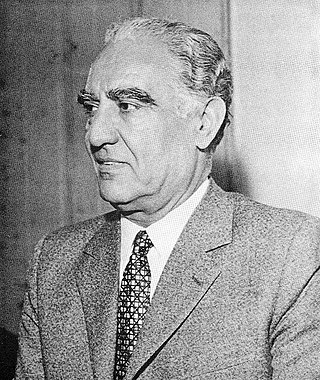
Manouchehr Eghbal was an Iranian physician and royalist politician. He was the Prime Minister of Iran from 1957 to 1960.

Hasan Ali Mansur was an Iranian politician who served as Prime Minister from 1964 to 1965. He served during the White Revolution of the Shah Mohammad Reza Pahlavi and was assassinated by a member of the Fada'iyan-e Islam.

The Cabinet of Iran is a formal body composed of government officials, ministers, chosen and led by a President. Its composition must be approved by a vote in the Parliament. According to the Constitution of the Islamic Republic of Iran, the President may dismiss members of the cabinet, but must do so in writing, and new appointees must again be approved by the Parliament. The cabinet meets weekly on Saturdays in Tehran. There may be additional meetings if circumstances require it. The president chairs the meetings. The Supreme Leader has the power to dismiss cabinet members like ministers and vice presidents, as well as the President, at any time, regardless of the Parliament's decisions.
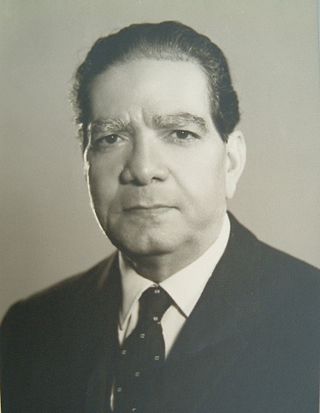
Abbas Aram (1906–1985) was an Iranian diplomat and served as foreign minister for two terms between 1959 and 1960 and between 1962 and 1966. In addition, he was the ambassador of Iran to various countries, including Iraq, the United Kingdom and China.
Events from the year 1964 in Iran.

Mehrdad Pahlbod, born as Ezatollah Minbashian, was an Iranian politician who served as the first culture minister of Iran from 1964 until 1978.
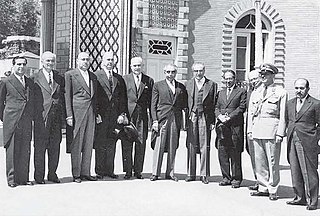
Ali Amini was appointed to rule by decree as the Prime Minister of Iran on 5 May 1961, succeeding Jafar Sharif-Emami. His cabinet was approved on 9 May 1961.
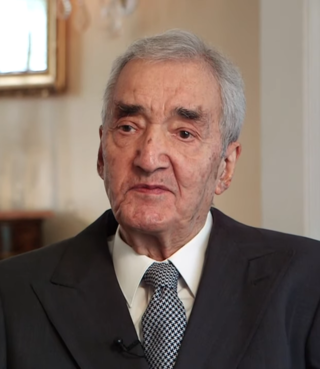
Alinaghi Alikhani was an Iranian economist who held government posts in the 1960s and was the first minister of economy of Iran. He also served as the chancellor of Tehran University.
Abdolhossein Behnia, also Latinized as Abdul Husain Behnia, was an Iranian politician who served as minister of finance several times during the reign of Shah Mohammad Reza Pahlavi. He served in the cabinet of Prime Minister Ali Amini and then of Asadollah Alam in the early 1960s.

Mohammad Ali Varasteh (1896–1989) was an Iranian statesman who held several cabinet posts in the 1950s and also, served as the governor of Isfahan Province. He was the head of the regency council which was formed soon after the Shah Mohammad Reza Pahlavi left Iran in January 1979.
Jahangir Tafazzoli (1914–1990) was an Iranian journalist and government official during the Pahlavi period. He held various official posts and established a newspaper entitled Iran-e Ma. He committed suicide on 20 December 1990.

The second government formed by Prime Minister Asadollah Alam was inaugurated on 19 February 1963. It replaced the first government of Alam which ended on 18 February when he submitted his resignation to the Shah Mohammad Reza Pahlavi. The cabinet lasted for nearly thirteen months until 8 March 1964 when Asadollah Alam resigned from the office. It was succeeded by the cabinet of Hassan Ali Mansur.
Ataollah Khosravani was an Iranian politician. He served as the secretary-general of Iran Novin Party and held several cabinet posts in the 1960s.

The cabinet led by Haj Ali Razmara was formed on 26 June 1950 and succeeded the cabinet led by Ali Mansur who was in office between April and June 1950. Razmara was a lieutenant general at the imperial army and was serving as the chief of the general staff when he was appointed by the Shah Mohammad Reza Pahlavi as the prime minister. It was the 33rd and first military cabinet in Iran since 1924. Behrooz Moazami also argues that it was one of the cabinets which did not follow the political agenda of the Shah in addition to the cabinets of Mohammad Mosaddegh and those of Ahmad Qavam in the Pahlavi rule. The Razmara cabinet ended on 11 March 1951 three days after the assassination of the prime minister.

The cabinet led by Prime Minister Manouchehr Eghbal of Iran lasted for three years between April 1957 and September 1960 making it one of the longest tenure cabinets of the Pahlavi rule. The cabinet succeeded the second cabinet of Hossein Ala' who resigned on 3 April 1957.

The cabinet led by Prime Minister Amir Abbas Hoveyda was inaugurated on 26 January 1965 to succeed the cabinet of Hassan Ali Mansur due to the assassination of Mansur on 21 January. Like its predecessor the cabinet was led by the Iran Novin Party.
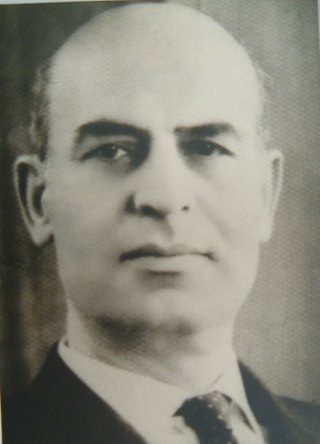
Javad Sadr was an Iranian diplomat and politician who held various public and cabinet posts. He was one of the Iranian ambassadors to Japan. He was the minister of interior and minister of justice in the 1960s.

The government formed by Prime Minister Asadollah Alam was inaugurated on 21 July 1962. It succeeded the Government of Ali Amini when Amini resigned from office on 18 July 1962.













